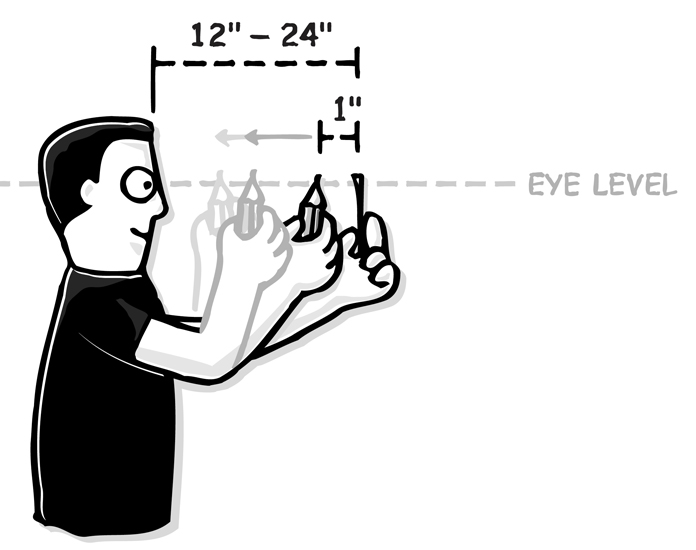
What Teachers Can Do to Help Keep Children’s Vision Healthy
It’s no secret that, after you, your child’s teacher is probably the most important adult in their life. Depending on where you live, your child spends anywhere from four to five days per week with their teacher. We all know that teachers are some of the best “noticers.” They know when your child is having problems with friends, when they are home sick from school, and when they are flourishing, and the best teachers know how to support children through their struggles and celebrate their successes. So what can teachers do to support children’s vision in the classroom?
Because teachers spend so much time with our kids, they are in the perfect position to spot any changes in a student’s health. Teachers are there when kids are using their eyes the most: at school, reading and writing. Issues that might not be present at home when your kid is socializing or eating dinner with you may be more apparent as they work, play, and interact with their school friends.
 Teachers are often your child’s best advocate. Here at RYV, we are so grateful for how much they contribute to our children’s lives, academic and otherwise. In this article, we’ll cover a few things educators can do to make sure their students’ eyes stay healthy and happy for years to come.
Teachers are often your child’s best advocate. Here at RYV, we are so grateful for how much they contribute to our children’s lives, academic and otherwise. In this article, we’ll cover a few things educators can do to make sure their students’ eyes stay healthy and happy for years to come.
Know Your Students
Well, we probably don’t have to harp on this one too much as most teachers already have it covered. That said, it’s important to have a solid grasp of the medical needs of the children under your care. Allergies and educational requirements are both important, but so is ocular health! If one of your students has special vision needs, then do your best to make sure they’re met.
In many cases, this can be as simple as moving the child to the front of the room so they can see the board. Be sure to alert the parent of this move so they know there’s an issue with their child’s vision. Additionally, do your best to ensure the child follows their prescribed treatment for existing vision problems. Eye patching for amblyopia (uneven vision resulting from misaligned eyes) is common among elementary-aged school children. It can be difficult for children to follow through with these types of treatment away from their parents, so it’s important to partner with the student’s guardians and healthcare team to ensure the treatment plan is enacted properly.
Most kids will be content to give their best pirate impression and make the most of a bad deal. But, some will remove patches, glasses, or other corrective devices the moment they’re out of parental sight. Talk with parents, and make sure you can support their efforts while they’re unable to supervise their child.
Keep an Eye Out for Learning-Related Vision Disorders in the Classroom
Parents might be in the best position to monitor most aspects of their child’s health. But, one arena where that doesn’t necessarily hold true is in the classroom. While parents can see grades come in, teachers are uniquely poised to watch them learn and process new information. This is especially the case for younger students who don’t bring as much work home with them. At the very least, educators need to be on the lookout for potential learning disorders. They must be ready to bring any concerns to a child’s parents.
Unsurprisingly, problems with vision can easily impact performance in the classroom. Eye misalignment and similar issues are common in younger children, and a student with an untreated condition can run into trouble fast. Reading can prove to be difficult, and even painful for children with subpar vision. It can cause asthenopia, otherwise known as eye strain.
Students who experience these issues undetected often have less enthusiasm for reading and writing, and even task avoidance. As a teacher, keep an eye out for signs such as excessive eye rubbing and squinting. And, watch out for a student closing or blocking one eye while reading, especially if they seem to be struggling with written material. While it takes a medical professional to diagnose and treat these problems, educators can at least keep watch for them. Let parents know if you’ve seen cause to schedule an eye exam.
Take Breaks
While the Common Core curriculum adopted by many schools has its upsides, there’s no doubt that it’s cutting into important downtime for children. Recesses seem to be going the way of the horse and buggy and, regardless of the impact of that decision on other aspects of health, it’s not a good trend for students’ eyes.
Taking a break from near-focus visual activity is extremely important, no matter what age you’re at. Focusing for too long on a book or screen can quickly cause eye strain. Concentrating on a nearby object for long stretches forces muscles in the eyes to work constantly to accommodate the task. Go too long without a break, and those muscles become fatigued, resulting in painful, tired eyes.
With the advent of the classroom tablet, these problems are due to become even more prevalent. While reading a paperback can certainly cause eyestrain, transitioning to a visual display introduces further problems.
Computer and tablet users tend to adopt a zombie-ish stare, holding unblinking contact with their screens for far longer than they would a book. This can quickly dry the eyes out. While that might sound innocent, it can be extraordinarily uncomfortable and may lead to unhealthy habits like excessive eye-rubbing.
So, take a break. Multiple breaks. Adults are often advised to take eye rests while working at computer screens. Children are, if anything, even more susceptible to overwork. So err on the side of caution and give students plenty of time to relax and refocus while working through a complex or laborious problem. Consider enacting the 10-10-10 rule in your classroom. While it might seem like a lot of rest time, your students’ eyes and brains will thank you. After all, no one wants to sit in a chair for hours on end, and frequent breaks could actually lead to more productivity.
What Else Should You Do for Children’s Vision in the Classroom?
As a teacher, you do so much for your kids. But, is there anything else you could be doing to safeguard your students’ vision? Above all else, educate yourself. Seek out advice from an actual physician. Vision problems in the classroom are so common and can cause an awful lot of grief if they’re ignored. Learn the signs and do everything you can to ensure that struggling students aren’t allowed to slip through the cracks. Especially when a simple visit to an eye doctor could solve the problem.
And, since you’re here, check through our site. There’s nothing wrong with setting a positive example for visual health. If you find yourself struggling to read your own whiteboard, it may be time to look into eye vitamins. Our essential vitamins should have you in perfect shape to check your students for latent visual disorders and contraband candy alike.
Our Rebuild Your Vision Ocu-Plus Formula Contains All 17 Vitamins, Minerals, and Herbal Supplements to Improve Your Eye Health!




Hi, I have been using you product on and off for over a year now and it surely works! Thank you for making such a difference to my life.
I have a question though. My son has Stargard’s disease which is the juvenile form of macular degeneration. My heart is breaking for him since he has become more myopic over the past year. Is there anything that you can recommend that could improve his nearsightedness?
Kind regards
Linda
Hi Linda,
Congratulations on your success. We are sorry to hear about your son and will reply personally in an email.